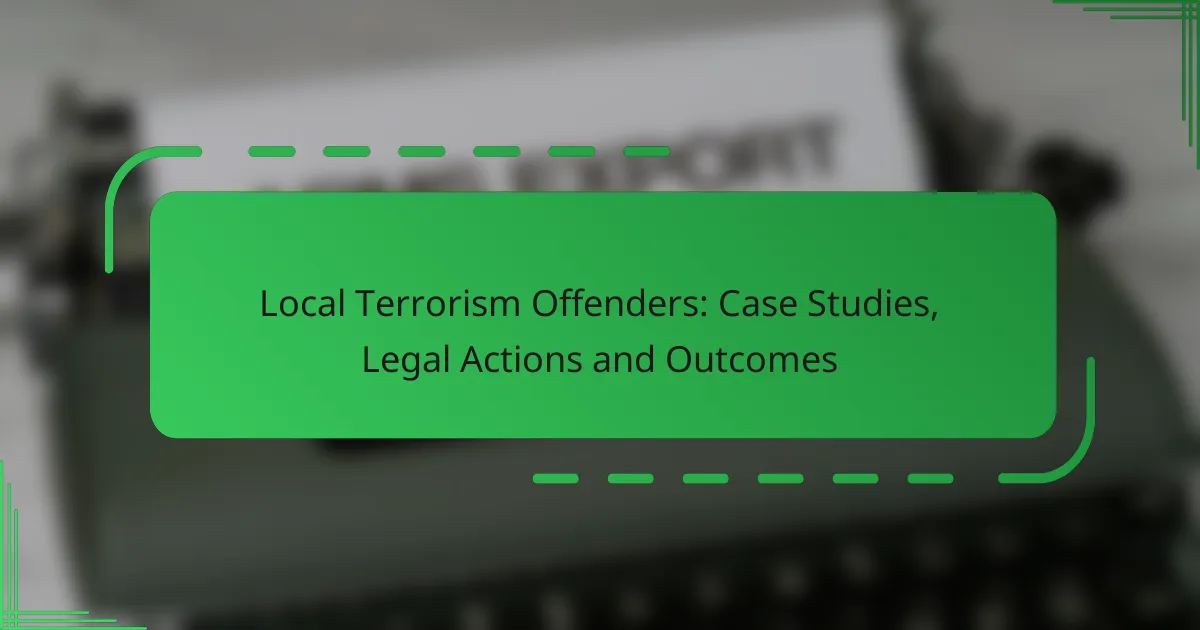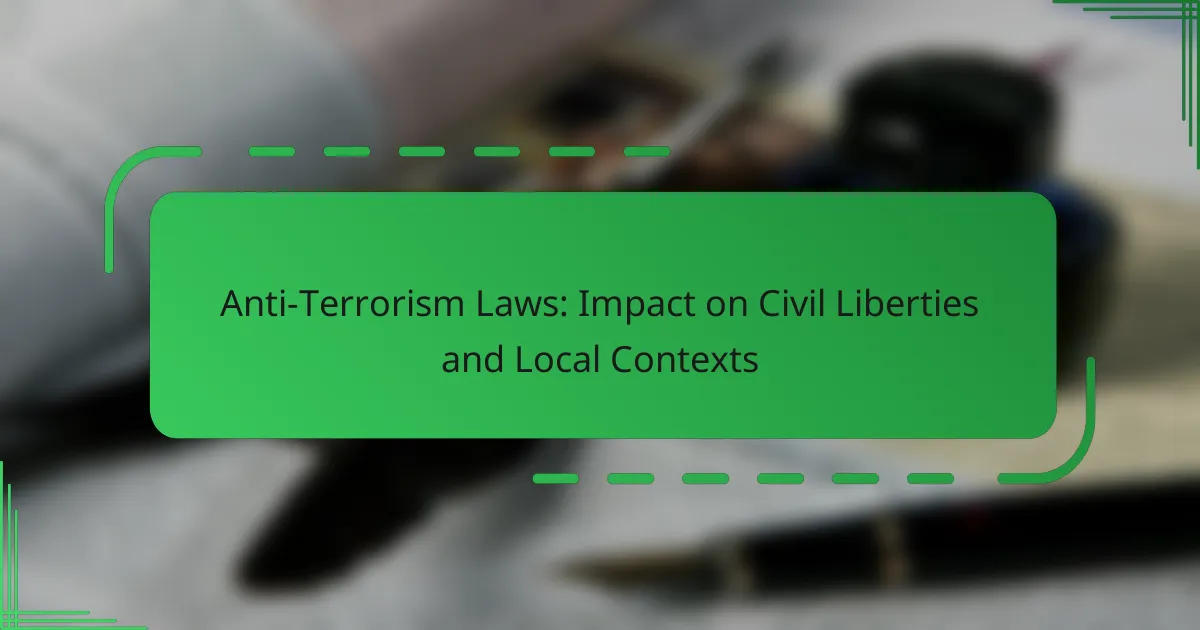This analysis explores the legal actions and outcomes associated with local terrorism offenders in the United States, focusing on criminal prosecutions and civil lawsuits aimed at ensuring accountability and justice for victims. Through case studies, we examine the motivations and methods behind these offenses, revealing the complexities of addressing terrorism within communities and the profound impact it has on social cohesion and trust among residents.
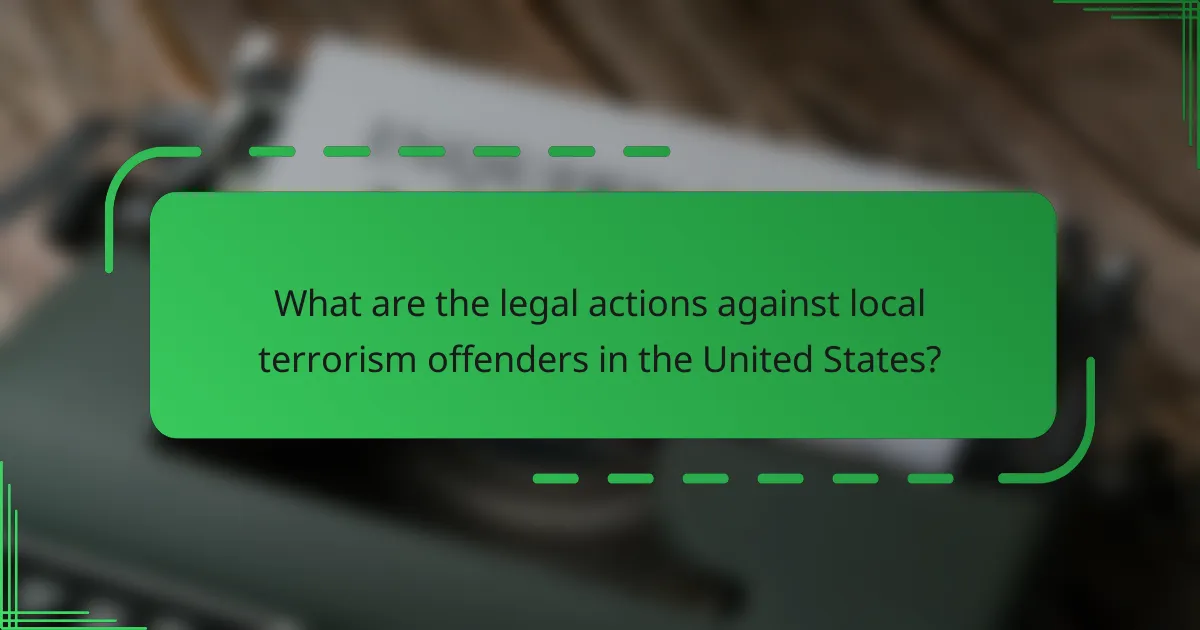
What are the legal actions against local terrorism offenders in the United States?
Legal actions against local terrorism offenders in the United States primarily include criminal prosecutions and civil lawsuits. These actions aim to hold individuals accountable for their involvement in terrorist activities and provide avenues for victims to seek justice.
Criminal prosecutions
Criminal prosecutions for local terrorism offenders typically involve charges such as conspiracy, providing material support to terrorist organizations, or committing acts of terrorism. The legal process begins with investigations led by agencies like the FBI, followed by arrests and formal charges in federal or state courts.
Prosecutors must present evidence to prove the offender’s intent and actions beyond a reasonable doubt. Convictions can lead to significant prison sentences, often ranging from several years to life imprisonment, depending on the severity of the crime and any prior convictions.
Civil lawsuits
Civil lawsuits allow victims of terrorism to seek financial compensation from offenders or associated entities. These lawsuits can be filed in addition to criminal charges and often target individuals, organizations, or even government entities that may have failed to prevent the acts of terrorism.
Victims may pursue damages for emotional distress, medical expenses, and loss of income. Successful civil suits can result in substantial monetary awards, although collecting these damages can be challenging, especially if the offender lacks financial resources.
Sentencing outcomes
Sentencing outcomes for local terrorism offenders vary widely based on the nature of the offense, the offender’s criminal history, and the jurisdiction. Federal guidelines typically impose harsher penalties for terrorism-related crimes compared to state laws.
Sentences can include lengthy prison terms, mandatory supervision after release, and fines. In some cases, offenders may also face civil penalties or be ordered to pay restitution to victims, further emphasizing the legal consequences of their actions.

How do case studies illustrate local terrorism offenses?
Case studies provide concrete examples of local terrorism offenses, showcasing the motivations, methods, and legal outcomes associated with these incidents. They highlight the complexities of addressing terrorism at the community level and inform legal actions and preventive measures.
Case study of the 2016 Orlando shooting
The 2016 Orlando shooting, which occurred at the Pulse nightclub, serves as a significant case study in local terrorism. The perpetrator, motivated by extremist ideologies, killed 49 individuals and injured many others, marking it as one of the deadliest mass shootings in U.S. history.
This incident prompted extensive legal actions, including investigations into the shooter’s background and affiliations, as well as discussions on gun control and hate crime legislation. The aftermath also led to increased security measures in public venues across the country.
Case study of the 2017 Charlottesville rally
The 2017 Charlottesville rally, which was organized by white supremacist groups, escalated into violence, resulting in the death of one counter-protester and injuries to many others. This event is a critical example of how local terrorism can manifest through organized hate groups and their actions.
Legal repercussions followed, with several participants facing charges related to violence and conspiracy. The rally sparked nationwide debates about free speech, hate speech, and the responsibilities of local governments in managing such events.

What are the consequences of local terrorism on communities?
Local terrorism can severely disrupt communities, leading to heightened fear, social fragmentation, and a decline in trust among residents. The aftermath often includes both immediate and long-term effects that can alter the fabric of daily life.
Impact on public safety
The impact of local terrorism on public safety is profound, as it can lead to increased police presence and heightened security measures. Communities may experience a rise in anxiety and vigilance, which can affect social interactions and community cohesion.
In response to incidents, local governments often implement stricter regulations and emergency protocols, which may include surveillance enhancements and community policing initiatives. These measures aim to restore a sense of safety but can also lead to feelings of being monitored among residents.
Economic repercussions
Local terrorism can have significant economic repercussions, affecting businesses and local economies. Areas directly impacted may see a decline in tourism and consumer spending, as people avoid places perceived as unsafe.
Additionally, businesses may incur costs related to increased security measures or repairs following an attack. In some cases, insurance premiums can rise, further straining local economies. Long-term economic recovery may require substantial investment in community rebuilding and support initiatives.
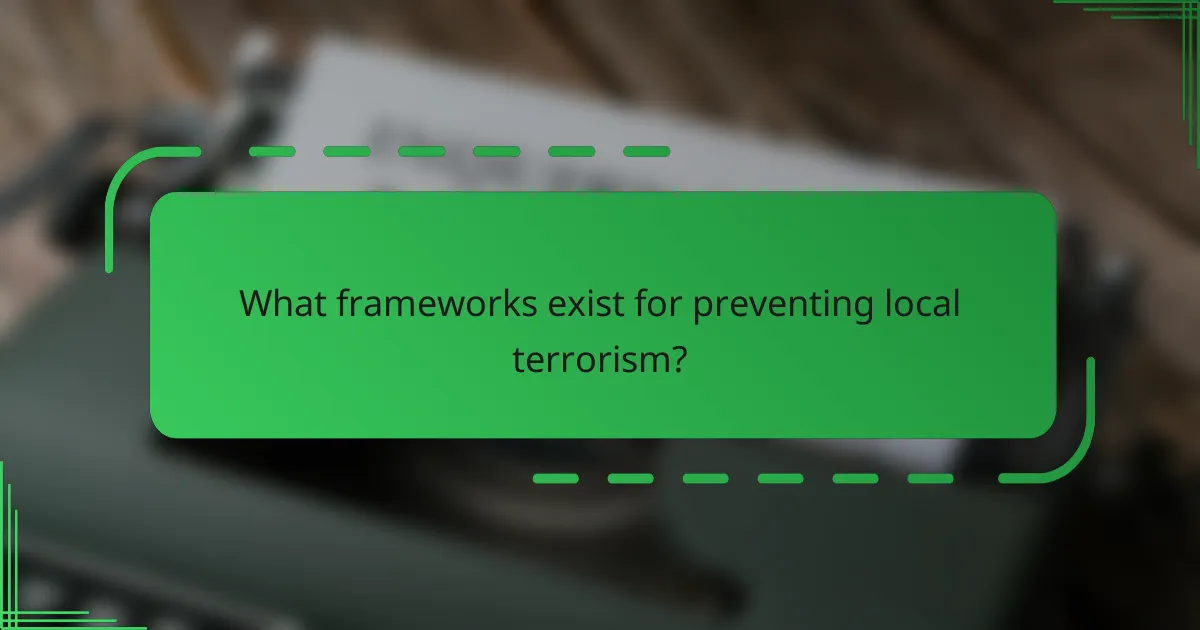
What frameworks exist for preventing local terrorism?
Preventing local terrorism involves a combination of community engagement and law enforcement partnerships. These frameworks aim to foster collaboration between citizens and authorities to identify and mitigate potential threats effectively.
Community engagement programs
Community engagement programs are designed to build trust between local populations and law enforcement. These initiatives often include workshops, town hall meetings, and outreach activities that encourage open dialogue about safety concerns and terrorism prevention.
Effective programs typically focus on educating community members about recognizing suspicious behavior and reporting it to authorities. For example, initiatives may provide training on how to identify radicalization signs or how to respond to potential threats in public spaces.
Law enforcement partnerships
Law enforcement partnerships involve collaboration between police agencies, local governments, and community organizations to enhance security measures. These partnerships can lead to the sharing of intelligence, resources, and best practices for countering terrorism.
For instance, joint task forces may be established to address specific threats, allowing for a more coordinated response. Additionally, regular communication between law enforcement and community leaders can help identify emerging risks and develop proactive strategies to address them.
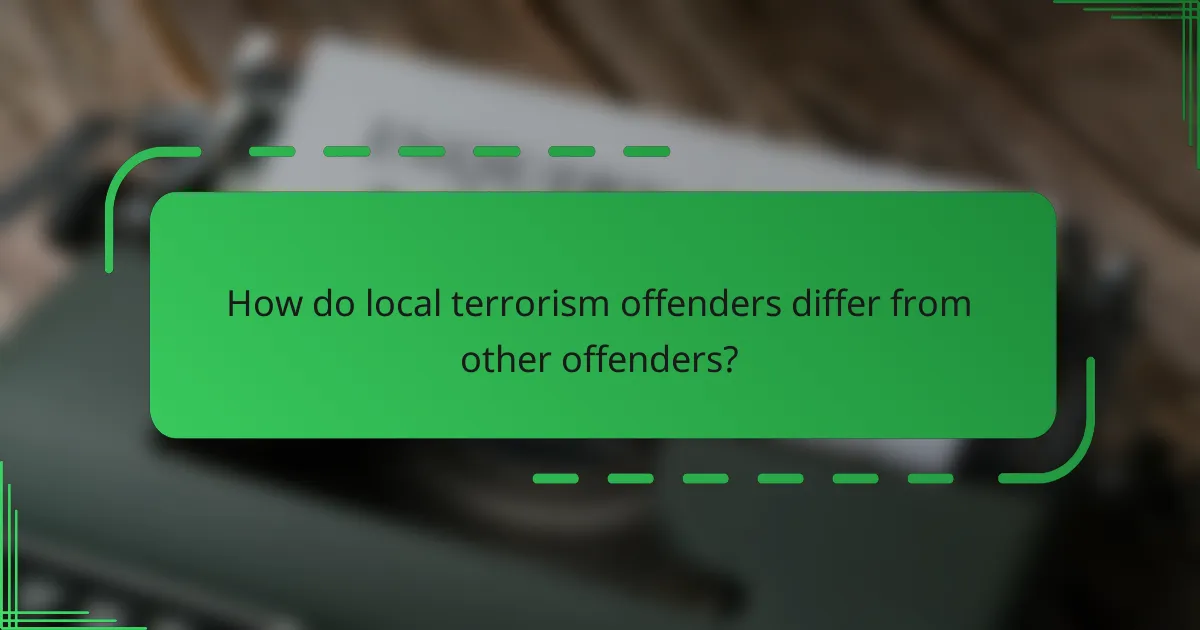
How do local terrorism offenders differ from other offenders?
Local terrorism offenders typically operate within specific communities, driven by distinct motivations and ideologies that set them apart from general criminal offenders. Their actions are often influenced by political, social, or religious beliefs, which can lead to targeted violence against particular groups or institutions.
Motivations and ideologies
Local terrorism offenders are often motivated by a strong ideological commitment, which can include nationalism, religious extremism, or political radicalism. These motivations frequently stem from perceived injustices or grievances within their communities, prompting individuals to take violent action to express their beliefs.
For example, some offenders may align with far-right or far-left movements, while others may be influenced by extremist interpretations of religious texts. Understanding these motivations is crucial for law enforcement and community leaders to effectively address and mitigate the risks associated with local terrorism.
Target selection
Target selection by local terrorism offenders is often strategic, focusing on individuals or institutions that symbolize their ideological opponents or represent broader societal issues. Common targets can include government buildings, places of worship, or public events, chosen for their potential to maximize impact and visibility.
In many cases, offenders may select targets based on their accessibility and the likelihood of media coverage, aiming to amplify their message. This underscores the importance of community vigilance and awareness in identifying potential threats and preventing attacks.
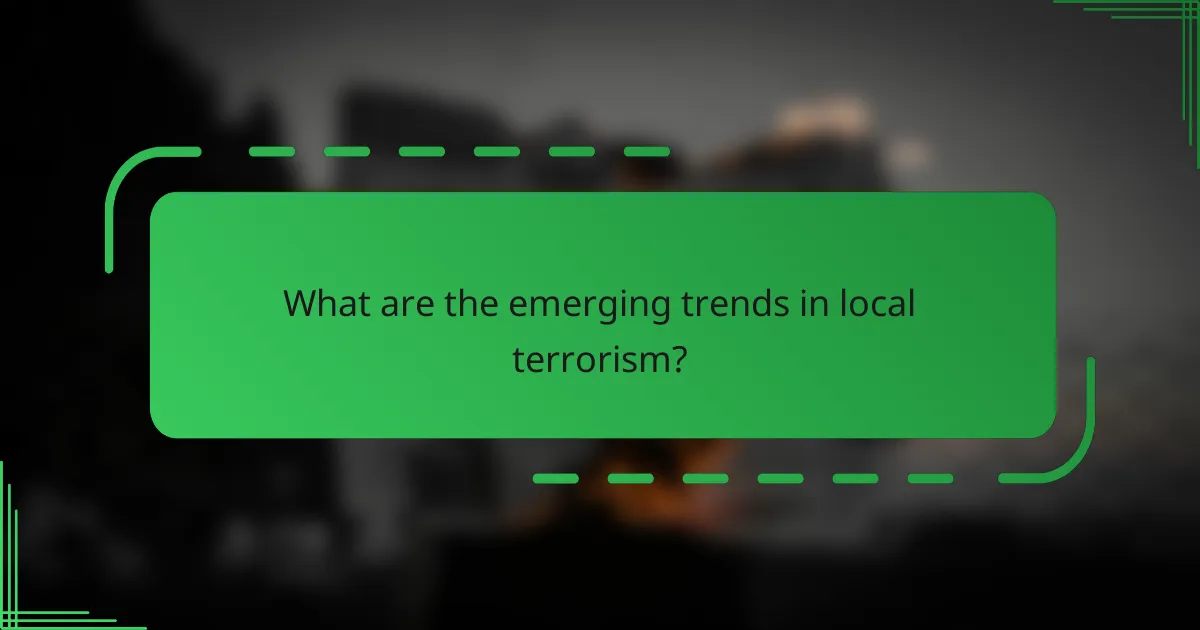
What are the emerging trends in local terrorism?
Emerging trends in local terrorism indicate a shift towards more decentralized and individualized forms of radicalization, often facilitated by digital platforms. These trends reflect changes in tactics, target selection, and the profiles of offenders, necessitating updated responses from law enforcement and community organizations.
Increased online radicalization
Online radicalization has become a significant factor in local terrorism, with social media and forums serving as breeding grounds for extremist ideologies. Individuals can now access propaganda and connect with like-minded peers, often leading to self-radicalization without direct organizational ties.
To combat this trend, authorities are focusing on monitoring online activity and promoting counter-narratives. Community engagement and education about the dangers of online extremism are essential to prevent vulnerable individuals from being drawn into radical ideologies.
Shift in target demographics
Recent cases show a shift in target demographics among local terrorism offenders, with attackers increasingly selecting victims based on identity markers such as race, religion, or political beliefs. This change reflects broader societal tensions and polarization, making it crucial for communities to recognize and address these underlying issues.
Law enforcement agencies are adapting by enhancing their intelligence-sharing capabilities and community outreach efforts. Understanding the motivations behind these shifts can help in developing targeted prevention strategies and fostering resilience within affected communities.
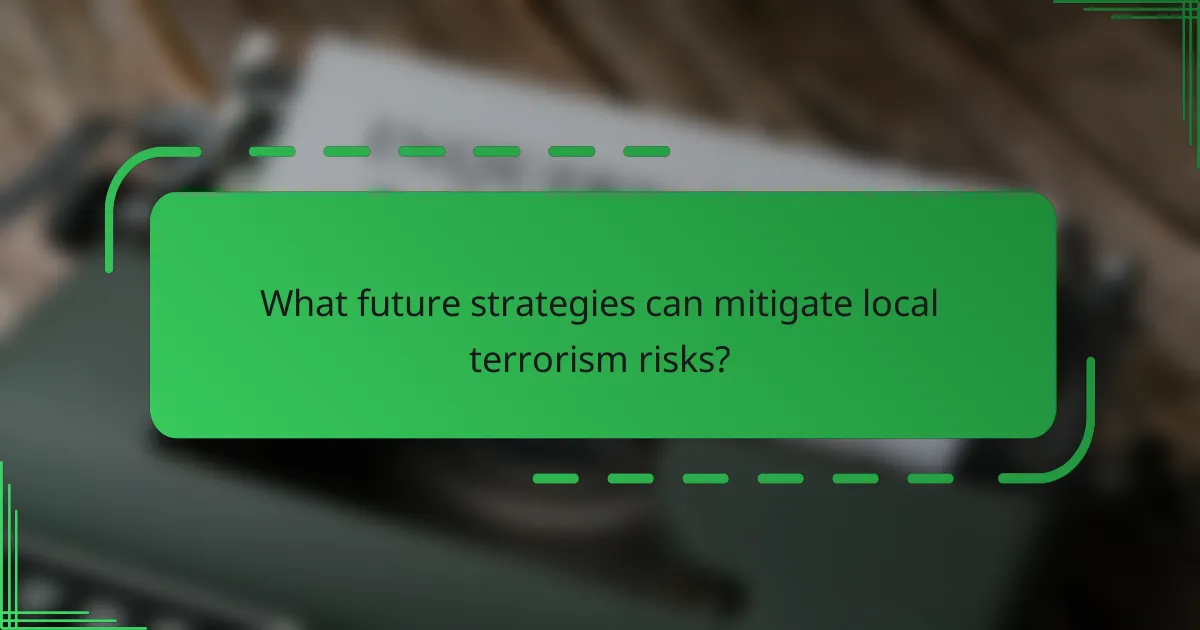
What future strategies can mitigate local terrorism risks?
Future strategies to mitigate local terrorism risks include enhancing intelligence sharing among agencies and implementing policy reforms that strengthen community resilience. These approaches aim to improve collaboration and empower communities to prevent radicalization and violence.
Enhanced intelligence sharing
Enhanced intelligence sharing involves improving communication and data exchange between law enforcement, intelligence agencies, and community organizations. This collaboration can lead to quicker identification of potential threats and more effective responses.
Agencies should establish formal protocols for sharing information, ensuring that data is timely and relevant. Regular joint training exercises can also help build trust and improve operational coordination among different entities.
Policy reforms for community resilience
Policy reforms aimed at community resilience focus on empowering local populations to resist radicalization and violence. This can include funding for educational programs, mental health services, and community engagement initiatives that foster inclusivity and understanding.
Local governments should consider implementing policies that promote social cohesion and address underlying grievances. Creating platforms for dialogue between diverse community groups can help mitigate tensions and build a united front against extremism.
